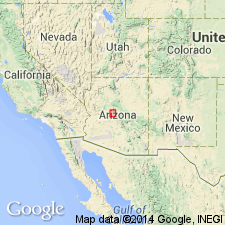
- Usage in publication:
-
- Big Bug Group*
- Modifications:
-
- Named
- Geochronologic dating
- Dominant lithology:
-
- Basalt
- Rhyolite
- AAPG geologic province:
-
- Southwestern Basin-and-Range region
Summary:
Named. The type locality is along Big Bug Creek originating west of Big Bug Mesa in the Mount Union quad and joining the Agua Fria River in the Mayer quad, Yavapai Co, AZ, in Southwestern Basin-and-Range region. Includes (ascending) the Green Gulch Volcanics, the Spud Mountain Volcanics, and the Iron King Volcanics. Mapped in Prescott, Mingus Mountain, Mount Union, and Mayer quads, Yavapai Co. Geologic map. Type locality cuts through complete section of Spud Mountain and Iron King Volcanics. Consists of rhyolite and basalt (Green Gulch), intertonguing andesitic and rhyolitic rocks, and amygdaloidal basalt flows (Spud Mountain), and pillow and amygdaloidal basalts (Iron King). Columnar sections. Zircon from Spud Mountain Volcanics yield an isotopic age of 1,775 +/-10 Ma. Is Precambrian.
Source: GNU records (USGS DDS-6; Denver GNULEX).
For more information, please contact Nancy Stamm, Geologic Names Committee Secretary.
Asterisk (*) indicates published by U.S. Geological Survey authors.
"No current usage" (†) implies that a name has been abandoned or has fallen into disuse. Former usage and, if known, replacement name given in parentheses ( ).
Slash (/) indicates name conflicts with nomenclatural guidelines (CSN, 1933; ACSN, 1961, 1970; NACSN, 1983, 2005, 2021). May be explained within brackets ([ ]).

